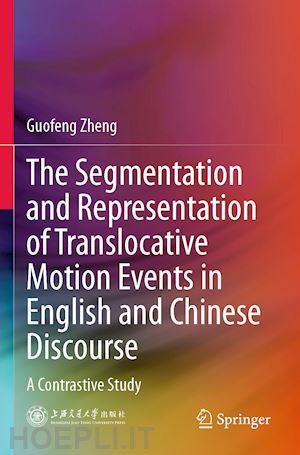List of Tables
List of Figures
List of Abbreviations
Chapter 1 Introduction: Events, Motion Events and Translocative Motion Events
1.1 Translocative Motion Events (TMEs)
1.1.1 Defining event
1.1.2 TME
1.2 Purpose and Significance of the Study
1.2.1 Purpose of the study
1.2.2 Significance of the study
1.3 Framework and Methodological Issues
1.4 The Roadmap
Chapter 2 MEP Principles and the Segmentation and Representation of the TMES
2.0 Introduction
2.1 Theoretical Issues
2.1.1 Talmyan dichotomy typology and motion event studies by other scholars
2.1.1.1 Talmyan dichotomy typology
2.1.1.2 Dichotomy or trichotomy
2.1.2 Event segmentation
2.2 Principles of MEP
2.2.1 The biuniqueness constraint
2.2.2 The macro-event linking principle
2.2.3 The referential uniqueness constraint
2.2.4 The unique vector constraint
2.2.5 The loss of MEP
2.2.6 A brief summary of Section 2.2
2.3 The Segmentation of Complex Motion Events and the TME Constructions with MEP
2.3.1 The conceptual structure and types of motion events
2.3.2 The segmentation of complex motion events
2.3.3 The TME constructions with MEP
2.4 The Components of TMEs and Parameter-setting
2.4.1 Figure and parameter-setting
2.4.2 Motion and parameter- setting
2.4.3 Path and parameter-setting
2.4.4 Ground and parameter-setting
2.5 Tertium Comparationis and the Hypothesis for This Study
2.6 Summary
Chapter 3 Corpus Tagging and Statistical Work
3.0 Introduction
3.1 Research Design
3.1.1 The parallel translation corpus
3.1.2 Sentence selection and tagging
3.1.3 Variables
3.2 English and Chinese TME Constructions
3.2.1 The MEP sentences in English and Chinese texts
3.2.2 The subevent constructions in English and Chinese texts
3.3 Representing English and Chinese TME Constructions
3.3.1 Who is moving
3.3.2 How to move
3.3.3 Which road to follow
3.3.4 Where to go
3.4 Summary
Chapter 4 Contrasting the Representation of English and Chinese TMEs
4.0 Introduction
4.1 The Representation of English and Chinese TMEs
4.1.1 English TMEs in the original texts
4.1.2 English TMEs in the translated texts
4.2.1 Chinese TMEs in the original texts
4.2.2 Chinese TMEs in the translated texts
4.2.3 At hand or in the distance? Part I: English and Chinese TME constructions in comparison
4.3 The TMEs Between English and Chinese
4.3.1 From English to Chinese
4.3.2 From Chinese to English
4.4 The Representation of Motion Event Components
4.4.1 The representation of Actants
4.4.2 The representation of Motion
4.4.3 The representation of Paths
4.4.5 At hand or in the distance? Part II: English and Chinese TME component representation in comparison
4.5 Beyond Surface Representation
4.6 Summary
Chapter 5 Conclusions
5.0 Introduction
5.1 Major Findings
5.2 Theoretical Implications
5.3 Limitations and Future Study
Bibliography











